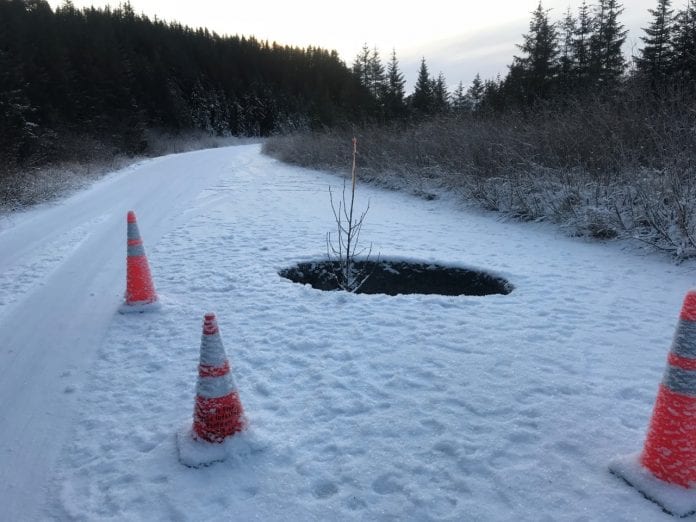
Recently a portion of a culvert at 21.5 Mile on the Copper River Highway collapsed, causing a hole in the middle of the gravel road. The state Department of Transportation plans on eventually repairing it, but in the meantime posted “Road Closed” signs and traffic cones on both sides of the depression, which is roughly 6 feet across and 4 feet deep.
The cause of the hole was evidently decay and rusting of the bottom of the steel cylinder.
However, Cordovans are quite accustomed to dodging pot holes of all sizes, and neither the hole nor the signs deterred several eager locals to travel further out the road in search of snow machine, four wheeling or other outdoor adventures.
One of those was Jack Stevenson, who now operates Child’s Glacier Tours here in the summer. Stevenson worked his way up through the ranks of the local Department of Transportation station, to eventually become manager. If anyone should know about culverts, it would be him.
In fact, Jack was somewhat of a Culvert Legend at the Mile 13 Station. Both he and fellow highway department worker Gary Weinrich pioneered techniques for unplugging culverts that were blocked by a furry adversary known as Castor Canadensis, or more commonly, beavers.
These large semiaquatic rodents specialize in building dams to create deep ponds, in which they can build huts to merrily survive and reproduce.
Well, beavers on the Copper River Delta must have been chomping on alders and slapping their tails in glee when human engineers showed up to build what appeared to them to be a gravel dam over 45 miles long, starting at Eyak River and extending all the way to Child’s Glacier.
It was originally called the Copper River and Northwestern Railway, and featured countless short bridges that were replaced with much cheaper culverts when the right-of-way was converted to a road.
Beavers might not be as smart as some of Heney’s railroad engineers, but they certainly recognized golden opportunities when the only things allowing water to escape through the road/dam was a few round circular holes four feet in diameter. Why, a single night of nocturnal effort would be all it would take to plug up them up.
Battle for Mile 21.5
A few of the culverts have been battlegrounds since their very installation. Stevenson and Weinrich spent many a day pulling dams out of the interior of the very culvert now collapsed at Mile 21.5.
This was after metal poles or grates at the entrances had not deterred the beavers, who found such structures an aid in their culvert-plugging efforts.
As is oft the case, the wars escalated. Just this past summer, beaver activities at the culvert under the highway near the Muskeg Meander Trail at Mile 19 made it obvious that if nothing was done, the highway would soon be flooded by waters backing up above the road.
This particular culvert has been the site of many confrontations between Man and Beast.
Not surprisingly, firepower was seen as a solution in the first stages of the conflict. One of the more entertaining early attempts involved putting several sticks of dynamite on a small raft, lighting a long fuse, and letting the craft float into the culvert and lodge itself against the interior dam before exploding.
The state crew was standing nearby on the highway, and let out a cheer as a small whomp was followed by water gushing out the other end of the culvert. Alas, their jubilation turned to dismay when the highway just near where they were standing suddenly sunk in the middle.
Stevenson admitted that he and Weinrick became somewhat expert at using the proper amount of dynamite, and length of fuse, when entering from below the interior culvert dams to blast them out.
“The fuses burned at one foot per minute, so we would measure the distance to the dam, and make sure we had plenty of extra time to race out.”
Perhaps the most famous dam extraction occurred directly under the Mile 13 Airport. When the airfield was built by the military early in WWII, a 300-foot culvert was buried under it perpendicular to the landing strip near the location of today’s exit ramp. Several large ponds, plus the deep trenches used to excavate gravel for the runway, posed a major drainage concern for “millions of gallons of water,” in the words of Stevenson.
Somehow the beavers built a plug in the center of culvert. Tom Justice, then manager of the local airport and highways, looked for volunteers to tear it out, with the enticement of extra days off.
Stevenson and James Dundas finally tackled the job. It took a couple days. With gravel deposits 8-to-10-inches deep decreasing the diameter of the culvert to just over 3 feet, the duo donned headlamps and went to work, entering bent over from the down-stream side.
More than a few times they beat a hasty retreat when hearing the sound of water flowing, only to have it trickle to a halt. At one point, a large part of the dam broke loose, and a very pungent large beaver carcass came floating out, joining them in a race to the exit.
“The fumes were awful,” Stevenson said.
Finally, after two days of hard labor, they succeeded. After that, a beaver “abatement” program was adopted to deal with that particular culvert.
However, for the shorter culverts along the road, the advent of excavators created a cleverer solution. Alongside the highway near each of the problematic culverts, a long branchless tree trunk can be seen. Grasped by the mechanical arm of the excavator, it is used as a long “poker” which is inserted into the culvert to knock out the interior dam.
So, for now, in the quiet of winter, a temporary truce has been reached. But rest assured that the sound of running water this spring will once again spurn Castor Canadensis, and the Department of Transportation into action.














